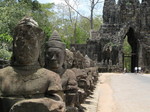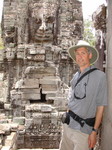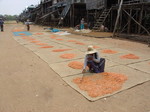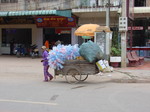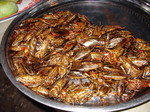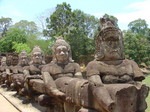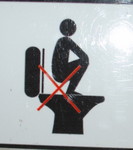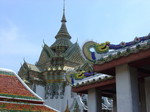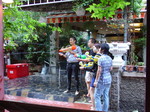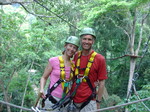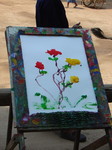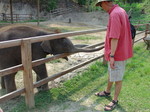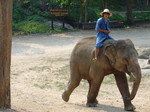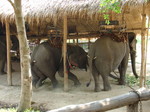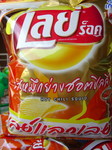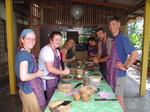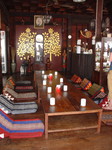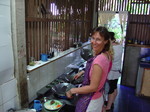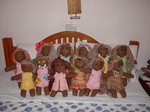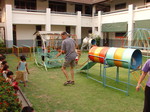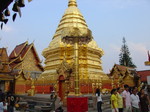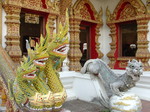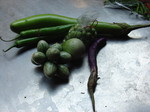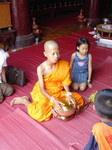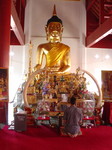The Kingdom of Cambodia
Over the next week we marveled at what Cambodians can transport on a bicycle, pickup or motorbike. I swear I counted over 25 people on one pickup truck, not to mention their belongings. I think our college car-stuffing team would've had a hard time competing with these people. I wish I had pictures of everything we saw, but since we never knew when to have the camera ready and were usually in shock or hysterics, my weak attempt at describing what we saw will have to suffice. After a while, nothing really surprised us, but the pickup truck with the (live) horse in the bed did amaze us. So did the 2 motorcycles strapped on top of a whole bunch of luggage in the bed of another pickup. Some other things we saw - 3 50lb. sacks of rice on a motorbike with one between the driver's legs and 2 stacked on the seat behind him, which his buddy was balancing on top of; dozens of dead chickens tied by their necks to boards running across the back of motorbikes; 2 dead pigs on a board on the back of motorbikes; guys on bicycles with 12' long 2x10s, or thereabouts, strapped lengthwise along the frames; 2 guys carrying a car door on a motorbike; several blocks of ice on motorbikes; families with the father driving, a kid between his legs, his wife on the back carrying a baby, all, of course, with no helmets or any straps of any kind; all kinds of stuff strapped across the back of motorbikes which seemed to defy the laws of gravity and, at the very least, required a very wide berth. I wish I had taken video! The other cool thing were the "gas stations". Actually, they were mostly used by motorbikes and tuk-tuks cause they did have regular gas stations. Along the roads you would see metal racks filled with bottles (soda, old liquor bottles, etc.) containing around a liter of gas. Perfect size for a motorbike. I was wondering what the heck they were when Tracy finally realized I was puzzled by them and said "Gas stations". Why not?
If you've read this far, you probably have a nagging question in the back of your head - "Why Cambodia?" You probably also have realized that Tracy and I don't go to "normal" places. Two words - Angkor Wat. 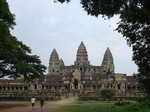 It's believed to be the world's largest religious structure, built in the 12th century if I remember right. At least, that was our initial motivation, but as we read more about the country we just felt it would be more intriguing than Thailand and that there would be more of a need there. We were right on both accounts. Things kept popping up on our radar screen regarding volunteering in Cambodia before we left and we hooked up with a woman named Ponheary Ly our first morning there. Which brings me to our second harrowing experience in Cambodia. Ponheary had no sooner picked us up when she collided with 3 kids on a motorbike. Her car just got a broken headlight, but the kids got a bit scraped up. We learned an interesting thing about accidents in Cambodia - that you have to settle things before the cops get there, otherwise you have to help "pay their salary". A nice way of saying that they don't get paid enough so if you don't give them some money they will impound all the vehicles involved. Ponheary, of course, had no money with her so she first asked us for $10 for the kids to get medical help, which they definitely needed. Then, she asked us for another $5 to placate the cops. She planned to pay us back, but we said no thinking that her money was better spent elsewhere.
It's believed to be the world's largest religious structure, built in the 12th century if I remember right. At least, that was our initial motivation, but as we read more about the country we just felt it would be more intriguing than Thailand and that there would be more of a need there. We were right on both accounts. Things kept popping up on our radar screen regarding volunteering in Cambodia before we left and we hooked up with a woman named Ponheary Ly our first morning there. Which brings me to our second harrowing experience in Cambodia. Ponheary had no sooner picked us up when she collided with 3 kids on a motorbike. Her car just got a broken headlight, but the kids got a bit scraped up. We learned an interesting thing about accidents in Cambodia - that you have to settle things before the cops get there, otherwise you have to help "pay their salary". A nice way of saying that they don't get paid enough so if you don't give them some money they will impound all the vehicles involved. Ponheary, of course, had no money with her so she first asked us for $10 for the kids to get medical help, which they definitely needed. Then, she asked us for another $5 to placate the cops. She planned to pay us back, but we said no thinking that her money was better spent elsewhere.
Let me back up a bit. We had actually arranged a meeting with her by email first after finding her organization (www.plf.org) on the internet. She helps Cambodian kids with supplies and uniforms for school. The school is free the first 6 years, but the supplies and uniforms are not. Many kids can't afford the $20 it cost for a year. When she asked us what we wanted to do, we warned her that we weren't teachers. Her response was, "Well, you speak English, don't you?" "Well, yes." "Great. That's all you need." We soon realized why. It was the first year the school had an English program and we figured out real quick that of the eight teachers who taught English, 3 could speak it OK and the rest didn't come up with an excuse fast enough to get out of it. So we spent 3 days, 7-11am and 1-5pm, in 95 degree heat with 98% humidity, with no A/C, with classes as big as 40+ kids trying to teach English using a book that was written for Euro teens in the 90s. Do 10 yr. old Cambodian kids really need to know what country Leonardo DiCaprio comes from or that Anna Kournikova is/was a tennis player? After the first day I wanted to quit. And Tracy had a hard time trying to come up with a good argument why we shouldn't. Mostly, we didn't want to fail after just one day so we went back for more punishment the next day. And by the 3rd day we were getting the hang of it despite the horrible book we had to work with. We were also totally exhausted at the end of each day. Thank God (or Buddha) for the 2 hour lunch breaks and for the great margaritas we had after we finished on the last day. But, I think both of us would do it again in a heartbeat. I don't think we'll ever forget 35 kids yelling "Teacher, me! Teacher, me!" when we asked them to come up to the board or answer a question. There were some shy and quiet ones, but most of them really wanted to learn.
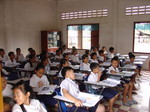
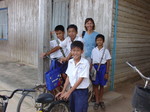
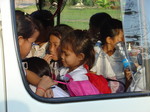
Back to those two words - Angkor Wat. Siem Reap used to be a dusty little city with nothing, but now huge hotels are all over the place. You can find a $10/night guesthouse or you can pay upwards of four or five hundred dollars for a luxury place. Actually, there's not just one temple, there are whole complexes of temples with the "jewel" being Angkor Wat.
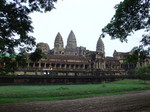
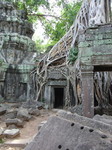
Not far from Siem Reap is one of the largest lakes in SE Asia, Tonle Sap. It is the lifeblood of central Cambodia. There is actually a large community of people that live in a floating village on the lake. Well, they do in the dry season when the lake level is much lower. In the rainy season the water level can rise as much as 30 feet or so and the lake is about 2/3 larger than in the dry season so the people have to move inland. We really wanted to go out and see it despite it being a bit touristy and harder to get to since we were late in the dry season. Another week or so and I don't think the boats could've gone out of the harbor that we went from. Some of the boats were already getting stuck. It's pretty funny though. They have most everything a normal village does - gas stations, restaurants, schools, a basketball court, and even a Catholic church. It just all happens to float.
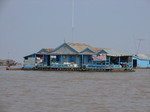
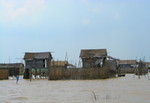

There is also a place called the Flooded Forest where the water rises so high that all but the highest branches of the trees are covered during the rainy season. It was an hour's boat ride up the lake but being out on water on a hot day seemed like a good idea so we checked it out as well. The village near it is all built on stilts 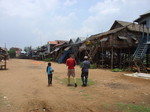 so they don't have to move in the rainy season, though they do have to get around in boats then. The water was so low that we had a hard time getting up the inlet where the village was and we were the only tourists in the village that day.
so they don't have to move in the rainy season, though they do have to get around in boats then. The water was so low that we had a hard time getting up the inlet where the village was and we were the only tourists in the village that day. 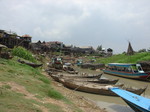 Before leaving we decided to eat lunch in the village at a place our guide took us to, rather than wait another hour til we got back to the floating village. It certainly wasn't your typical restaurant. No menus. Our guide simply asked us what we wanted - chicken or pork. Then he showed us through the house to our table, which shared a room with some beds. A while later, after we had drinks, he asked us how we wanted our chicken cooked. We realized that the cook had to go out and kill the chicken first. We heard a lot of chopping and commotion in the kitchen, and after what seemed like forever, a woman appeared with a plate of food that smelled great. A closer look showed us that it was chicken alright, but it was all the bones, neck, back, etc. chopped up. Hardly a piece of meat to be found. Then, out came another plate so we thought, "Oh, here's the meat." It was fried chicken, but again hardly any meat. Luckily there was a lot of rice. When we asked how much we owed (no menu, no checks) we were shocked when the girl said $15! You have to realize, that would've been the most expensive meal we had our whole time in Cambodia. We usually had dinner for two, even with a beer, for $8-13. We settled on $10 and got out of there. I think they were trying to make up for the lack of tourists.
Before leaving we decided to eat lunch in the village at a place our guide took us to, rather than wait another hour til we got back to the floating village. It certainly wasn't your typical restaurant. No menus. Our guide simply asked us what we wanted - chicken or pork. Then he showed us through the house to our table, which shared a room with some beds. A while later, after we had drinks, he asked us how we wanted our chicken cooked. We realized that the cook had to go out and kill the chicken first. We heard a lot of chopping and commotion in the kitchen, and after what seemed like forever, a woman appeared with a plate of food that smelled great. A closer look showed us that it was chicken alright, but it was all the bones, neck, back, etc. chopped up. Hardly a piece of meat to be found. Then, out came another plate so we thought, "Oh, here's the meat." It was fried chicken, but again hardly any meat. Luckily there was a lot of rice. When we asked how much we owed (no menu, no checks) we were shocked when the girl said $15! You have to realize, that would've been the most expensive meal we had our whole time in Cambodia. We usually had dinner for two, even with a beer, for $8-13. We settled on $10 and got out of there. I think they were trying to make up for the lack of tourists.
On our last day, we hired a tuk-tuk driver to take us to an orphanage that we had seen while touring around the temples. We thought it would be a good place to deliver the dolls. A young man showed us around the 2 room building that housed about 50 kids. He was 21 and had grown up in an orphanage himself, but still looked like he was one of the kids. They had a kitchen, toilets and a generator for electricity, but they used the lake across the street to bathe. The kids mostly slept on mats on the floor. We had brought a doll that a Cambodian girl had decorated with traditional Khmer clothing. She was an orphan in Cambodia but was adopted by the sister of one of Tracy's friends. The kids eyes lit up when they saw it and heard the story.
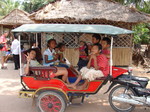
They were so excited to get all of the dolls, even the boys. In fact, one of the boys claimed the Cambodian doll for his own. Within minutes they were playing with the dolls' hair and changing around their clothes and stuff. It felt really good to see their smiling faces. I wondered if we should've stayed longer and played with them, but it just seemed like they were engrossed in the dolls and it was better to let them play on their own. The need is so great in Cambodia. Only the poorest of the poor children can come to this orphanage, but it is growing and there are others as well. The kids all go to school and you can tell they are loved.
The next morning we took a cab back to the border and were entertained by all the crazy things we saw on the way - horses in pickup trucks, pigs on the back of motorbikes, each thing more unbelievable than the last. I almost forgot to mention the traffic in Cambodia. I wish I could put into words how the traffic flows there. It really is something to sit back and just watch for a while. You have to realize, first, that there are as many, if not more, bicycles and motorbikes on the road than there are cars, and they often don't stick to their side of the road. At an intersection it's like a dance, or a weave, or 4 streams coming together. There's no neat orderly progression of vehicles waiting for their light to turn green. In fact, most of the time there's no light. From the outside it seems like chaos, but it's not. And, it works...somehow. If someone coming the other way is turning left and you're going straight, they don't wait for you to pass. They turn as if you weren't there. And you don't slam on the brakes and hit the horn. You simply go around them to the left, or further to the right if that works better. If you're crossing heavy traffic, you don't wait on your side of the intersection for the other traffic to clear. You venture out into the middle and the cross traffic veers around you - on the left or right - until you reach the other side. The key is, for the most part, everyone keeps moving. If you were carrying 30 chickens to market on the back of your motorbike, you wouldn't want to stop either. I know I'm not doing it justice. Next time I'll have to take a video.
Back in Thailand, the bus ride to Bangkok was far less entertaining. We looked forward to one last Thai massage at the airport hotel before our long journey home. At $11/hour we felt like we were being cheated a bit, but we had to remind ourselves that $11 would be dirt cheap in another day or two.
You can also see more pictures at http://www.flickr.com/photos/23798449@N04/sets/
